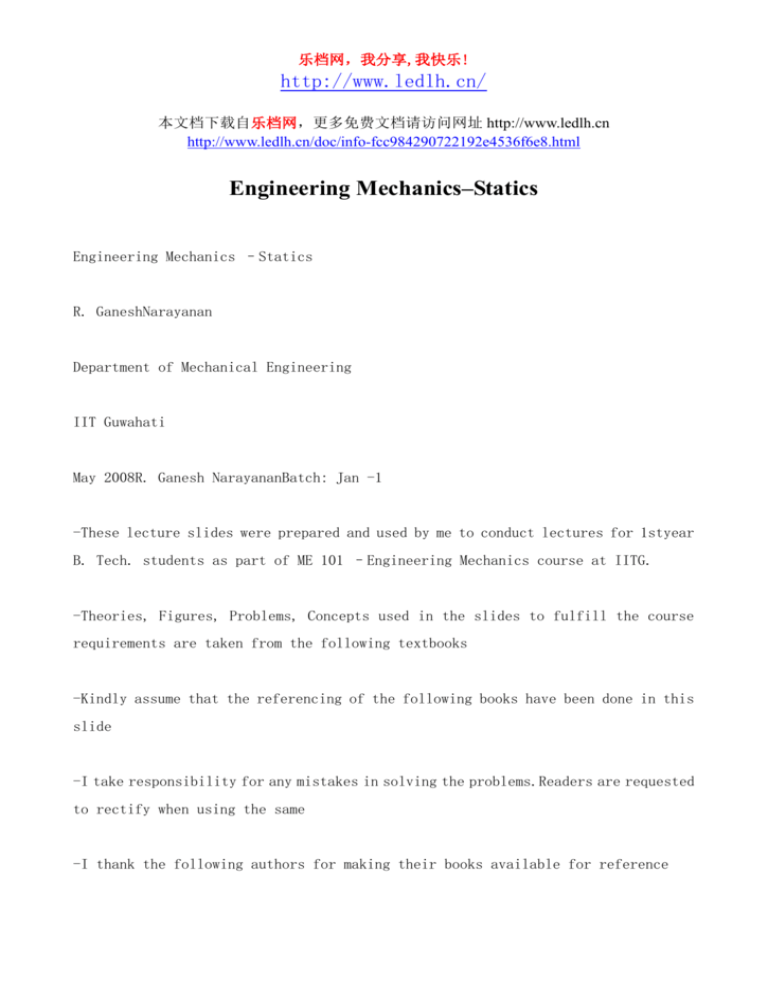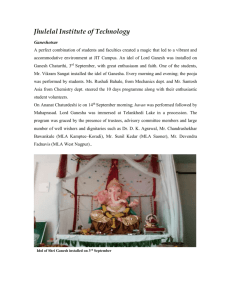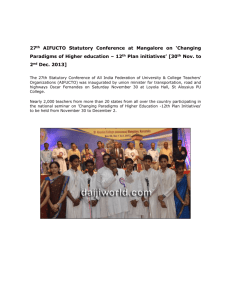乐档网,我分享,我快乐! http://www.ledlh.cn/ 本文档下载自乐档网,更
advertisement

乐档网,我分享,我快乐! http://www.ledlh.cn/ 本文档下载自乐档网,更多免费文档请访问网址 http://www.ledlh.cn http://www.ledlh.cn/doc/info-fcc984290722192e4536f6e8.html Engineering Mechanics–Statics Engineering Mechanics –Statics R. GaneshNarayanan Department of Mechanical Engineering IIT Guwahati May 2008R. Ganesh NarayananBatch: Jan -1 -These lecture slides were prepared and used by me to conduct lectures for 1styear B. Tech. students as part of ME 101 –Engineering Mechanics course at IITG. -Theories, Figures, Problems, Concepts used in the slides to fulfill the course requirements are taken from the following textbooks -Kindly assume that the referencing of the following books have been done in this slide -I take responsibility for any mistakes in solving the problems.Readers are requested to rectify when using the same -I thank the following authors for making their books available for reference 乐档网,我分享,我快乐! http://www.ledlh.cn/ R. GaneshNarayanan 1.Vector Mechanics for Engineers –Statics& Dynamics, Beer & Johnston; 7thedition2.Engineering Mechanics Statics& Dynamics, Shames; 4thedition 3.Engineering Mechanics StaticsVol. 1, Engineering Mechanics Dynamics Vol. 2, Meriam& Kraige; 5thedition4.Schaum’ssolved problems series Vol. 1: Statics; Vol. 2: Dynamics, Joseph F. Shelley Batch: Jan -May 2008 R. Ganesh Narayanan 2 Engineering mechanics -Deals with effect of forces on objects Mechanics principles used in vibration, spacecraft design, fluid flow, electrical, mechanical m/cdesign etc. Statics: deals with effect of force on bodies which are not moving Dynamics: deals with force effect on moving bodiesWe consider RIGID BODIES–Non deformable R. Ganesh Narayanan 3 乐档网,我分享,我快乐! http://www.ledlh.cn/ Scalar quantity: Only magnitude; time, volume, speed, density, mass… Vector quantity: Both direction and magnitude; Force, displacement, velocity, acceleration, moment… V = IvIn, where IvI= magnitude, n = V / IvI n -dimensionless and in direction of vector ‘V’ y j In our course: x i i, j, k –unit vectors z k R. Ganesh Narayanan4 Dot product of vectors: A.B = AB cosθ; A.B = B.A (commutative) 乐档网,我分享,我快乐! http://www.ledlh.cn/ A.(B C) = A.B A.C (distributive operation)i . i = 1 A.B = (Axi Ayj Azk).(Bxi Byj Bzk) = AxBx AyBy AzBz i . j = 0 Cross product of vectors: A x B = C; ICI = IAI IBI Sin θ; AxB= -(BxA) C x (A B) = C x A j i k j i k i kAZBZ j 5 AYBY C x B 乐档网,我分享,我快乐! http://www.ledlh.cn/ k x j = -i; i x i = 0 AxBX R. Ganesh Narayanan AxB= (Axi Ayj Azk)x(Bxi Byj Bzk) = (AyBz-AzBy )i ( )j ( )k Force: -action of one body on another -required force can move a body in the direction of action, otherwise no effect -some times plastic deformation, failure is possible-Magnitude, direction, point of application; VECTOR 乐档网,我分享,我快乐! http://www.ledlh.cn/ Force, Direction of motion Body movesForce bulging 6 Force system: Magnitude, direction and point of application is important WIRE External effect: Forces applied (applied force); Forces exerted by bracket, bolts, foundation….. (reactive force) Internal effect: Deformation, strain pattern –permanent strain; depends on material properties of bracket, bolts… R. Ganesh Narayanan7 Transmissibility principle: A force may be applied at any point on a line of action without changing the resultant effects of the force applied external to rigid body on which it actsMagnitude, direction and line of action is important; not point of application 乐档网,我分享,我快乐! http://www.ledlh.cn/ Line of P P R. Ganesh Narayanan8 Concurrent force: Forces are said to be concurrent at a point if their lines of action intersect at that point Parallelogram law of forcesPolygon law of forces F1, F2 are concurrent forces R will be on same planeR = F1 F2 R does not Two dimensional force system 乐档网,我分享,我快乐! http://www.ledlh.cn/ Rectangular components: j Fy F θFx i ve -ve ve -ve F = Fx Fy; both are vector components in x, y directionFx= fxi ; Fy= fyj; fx, fyare scalar quantities Therefore, F = fx i fyj Fx= F sin θ 2 fy2; θ= tan -1(fy/fx) 乐档网,我分享,我快乐! http://www.ledlh.cn/ R. Ganesh Narayanan10 Two concurrent forces F1, F2Rx = ΣFx; Ry= ΣFyF1 j F2 DERIVATION R. Ganesh Narayanani 11 Moment: Tendency to rotate; torque Moment about a point: M = Fd Magnitude of moment is proportional to the force ‘F’andmoment arm ‘d’ to the LOA of force UNIT : N-m Moment is perpendicular to plane about axis O-OCounter CW = ve; CW = -veR. Ganesh 乐档网,我分享,我快乐! http://www.ledlh.cn/ Narayanan 12 Cross product: M = r x F; where ‘r’is the position vectorwhich runs from the moment reference point ‘A’to any point on the LOA of ‘F’M = Fr sin α; M = Fd M = r x F = -(F x r): sense is important Sin α= d / r R. Ganesh Narayanan13 Varignon’stheorem: The moment of a force about any point is equal to the sum of the moments of the components of the forces about the same point Concurrent forces –P, Q Mo= r x R = r x (P Q) = Moment of ‘P’ Usefulness: 乐档网,我分享,我快乐! http://www.ledlh.cn/ Resultant ‘R’–moment arm ‘d’ Moment of ‘Q’ Force ‘P’–moment arm ‘p’; Force ‘Q’–moment arm ‘q’Mo= Rd = -pP R. Ganesh Narayanan 14 Calculate the magnitude of the momentabout ‘O’of the force 600 N 1) Mo = 600 cos40 (4) 600 sin 40 (2) = 2610 Nm (app.) = -771.34-1839 = 2609.85 Nm (CW);mag= 2610 Nm R. Ganesh Narayananj i 15 in mm Couple:Moment produced by two equal, opposite and non-collinear forces qQ 乐档网,我分享,我快乐! http://www.ledlh.cn/ =>-F and F produces rotation=>Mo = F (a d) –Fa= Fd; Perpendicular to plane?Independent of distance from ‘o’, depends on ‘d’only ?moment is same for all moment centers R. Ganesh Narayanan 16 Vector algebra method CCW CW M = rax F rbx (-F) = (ra-rb) x F = r x F Equivalent couples ?Changing the F and d values does not change a given couple as long as the product (Fd) remains same ?Changing the plane will not alter couple as long as it is parallel R. Ganesh Narayanan 17 EXAMPLE 乐档网,我分享,我快乐! http://www.ledlh.cn/ F All four are equivalent couples R. Ganesh Narayanan18 Force-couple system =>Effect of force is two fold –1) to push or pull, 2) rotate the body about any axis ?Dual effect can be represented by a force-couple syatem ?a forcecan be by a force and couple R. Ganesh Narayanan19 乐档网,我分享,我快乐! http://www.ledlh.cn/ EXAMPLE o Mo = Y N m Mo = 80 (9 sin 60) = 624 N m; CCW R. Ganesh Narayanan20 Resultants To describe the resultant action of a group or system of forcesResultant:simplest force combination which replace the original forces without altering the external effect on the body to which 乐档网,我分享,我快乐! http://www.ledlh.cn/ the forces are applied R = F1 F2 F3 ….. = ΣF Rx = ΣFx; Ry= ΣFy; R = (ΣFx)2 Θ= tan -1(Ry/Rx) R. Ganesh Narayanan21 How to obtain resultant force ? F3 D1; F2 –D2; F3 –D3 M1 = F1d1; M2 = F2d2; M3 = F3d3 R. Ganesh Narayanan (ΣFy)2 乐档网,我分享,我快乐! http://www.ledlh.cn/ 22 F1 – Principle of moments Summarize the above process: R = ΣF Mo = ΣM = Σ(Fd)Mo = Rd First two equations: reduce the system of forces to a force-couple system at some point ‘O’ Third equation: distance ‘d’from point ‘O’to the line of action ‘R’=> VARIGNON’S THEOREM IS EXTENDED HERE FOR NON-CONCURENT FORCES R. Ganesh Narayanan 23 Reference books 乐档网,我分享,我快乐! http://www.ledlh.cn/ 1.Vector Mechanics for Engineers –Statics& Dynamics, Beer & Johnston; 7thedition2.Engineering Mechanics Statics& Dynamics, Shames; 4thedition 3.Engineering Mechanics StaticsVol. 1, Engineering Mechanics Dynamics Vol. 2, Meriam& Kraige; 5thedition4.Schaum’ssolved problems series Vol. 1: Statics; Vol. 2: Dynamics, Joseph F. Shelley STATICS –MID SEMESTER –DYNAMICS Tutorial: Monday 8 am to 8.55 am R. Ganesh Narayanan24 ENGINEERING MECHANICS TUTORIAL CLASS: Monday 8 AM TO 8.55 AM Tutorial Groups Roll Numbers Class RoomTutors From To TG10701010107010141 (41 Students)L2Prof. R. TiwariTG2 乐档网,我分享,我快乐! http://www.ledlh.cn/ 0701014207010149 (8 Students)1G1 Dr. senthilvelan 07010201 07010233 (33 Students)TG3 0701023407010249 (16 Students)1G2R. GaneshNarayanan 07010301 07010325 (25 Students)TG4 0701032607010353 (28 Students)1202Dr. M. Pandey 07010401 07010413 (13 Students)TG5 0701041407010449 (36 Students)1205Dr. SaravanaKumar 07010601 07010605 (5 Students) LECTURE CLASSES: LT2 (one will be optional):Monday 3 pm to 3.55 pmTuesday 2 pm to 2.55 pmThursday 5 pm to 5.55 pmFriday 4 pm to 4.55 pm R. Ganesh Narayanan 乐档网,我分享,我快乐! http://www.ledlh.cn/ 25 Three dimensional force system Rectangular components Fx= F cosθx; Fy= F cosθy; Fz= F cosθz F = Fxi Fyj Fzk l, m, n are directional cosines of ‘F’ = F (i cosθx j cosθy Fzk F θzθy Fyj o θxFxi R. Ganesh Narayanan 26 k cosθz) = F (l i m j n k)F = F nf 乐档网,我分享,我快乐! http://www.ledlh.cn/ Moment in 3D A -a plane in 3D structureMo = F d (TEDIOUS to find d) or Mo = r x F = –(F x r) (BETTER) Described in determinant form: i j krxrYrZFX F Y FZ Expanding …R. Ganesh Narayanan 27 Evaluating the cross product 乐档网,我分享,我快乐! http://www.ledlh.cn/ Mo = (ryFz-rzFy)i (rzFx–rxFz)j (rxFy–ryFx)kMx= ryFz–rzFy; My = rzFx–rxFz; Mz= rxFy–ryFxMagnitude of the moment Mλof F about λ= Mo . n (scalar reprn.) (vector reprn.) Scalar triple product rxryrzFx FYFZα, β, γ–DCsof n αβ γ 28 Varignon’stheorem in 3D Mo = rxF1 rxF2 rxF3 …= Σ(r x F) 乐档网,我分享,我快乐! http://www.ledlh.cn/ = r x (F1 F2 F3 …)= r x (ΣF) = r x R M M = rax F rbx –F = (ra-rb) x F = rxF 29 2D force system; equ. Force-couple; principle of moments ?Evaluate components of F1, F2, F3, F4?Rx = ΣFx; Ry= ΣFy ?R = Rx i Ryj?α= tan -1(Ry/Rx) Ry R Rx R. Ganesh Narayanan?R = 199i 30 F1 14.3j; α= 4.1 deg 乐档网,我分享,我快乐! http://www.ledlh.cn/ Find F1 and F2 R = F1 F2 3000(cos15i–sin 15j) = F1(cos30i–Sin 30j) F2(cos45i–sin 45j)EQUATING THE COMPONENTS OF VECTOR,F1 = 2690 N; F2 = 804 N R. Ganesh Narayanan31 Find the moment Mo of 780 N about the hinge point T = -780 COS20 i –780 sin20 j= -732.9 i –266.8 j r = OA = 10 cos60 i 10 sin 60 j = 5 i 8.6 jMo = r x F = 5014 k ; Mag= 5014 Nm R. Ganesh NarayananOC –FLAG POLEOAB –LIGHT FRAMED –POWER WINCH 32 Replace couple 1 by eq. couple p, -p; find 乐档网,我分享,我快乐! http://www.ledlh.cn/ M = 100 (0.1) = 10 Nm (CCW)M = 400 (0.04) cosθ10 = 400 (0.04) cosθ=> Θ= 51.3 deg R. Ganesh Narayanan100N 33 100N Find the resultant of four forces and one couple which act on the plateRx = 40 80cos30-60cos45 = 66.9 NRy= 50 80sin 30 60cos45 = 132.4 NR = 148.3 N; Θ = tan-1 (132.4/66.9) = 63.2 deg 60 N Mo = 140-50(5) 60cos45(4)-60sin45(7) = -237 Nm Final LOA of R:148.3 d = 237; d = 1.6 m LOA of R with x-axis: 乐档网,我分享,我快乐! http://www.ledlh.cn/ (Xi yj) x (66.9i 132.4j) = -237k(132.4 x –66.9 y)k= -237k132.4 x -66.9 y = -237 Y = 0 => x = b = -1.792 m R. Ganesh Narayanan Couples in 3D M M = rax F rbx –F = (ra-rb) x F = rxF Equivalent couples 乐档网,我分享,我快乐! http://www.ledlh.cn/ M = Fd 35 How to find resultant ? R = ΣF = F1 F2 F3 … Mo = ΣM = M1 M2 M3 …= Σ(rxF) M = Mx2 My2 Mx= ; My = Mz2; ; R = ΣFx2 ΣFy2 ΣFz2 Mz= R. Ganesh Narayanan36 Equilibrium Body in equilibrium -necessary & sufficient condition:R = ΣF = 0; M = ΣM = 0 Equilibrium in 2D Mechanical system: body or group of bodies which can be conceptually isolated from all other bodies System: single body, combination of bodies; rigid or non-rigid; combination of fluids and solidsFree body diagram -FBD: => Body to be analyzed is isolated; Forces acting on the body are represented –action of one body on other, gravity attraction, magnetic force etc. 乐档网,我分享,我快乐! http://www.ledlh.cn/ => After FBD, equilibrium equns. can be formed R. Ganesh Narayanan 37 Modeling the action of forces Imp Imp R. Ganesh Narayanan38 Meriam/Kraige FBD -Examples R. Ganesh NarayananEquilibrium equns. Can be solved, ?Some forces can be zero?Assumed sign can be different 39 Meriam/Kraige Types of 2D equilibrium Concurrent at a point: ΣFx= 0; ΣFy= 0 乐档网,我分享,我快乐! http://www.ledlh.cn/ x F3 = 0Y X F1 F4 Parallel: ΣFx= 0; ΣMz = 0 R. Ganesh Narayanan Y X General: ΣFx= 0; ΣFy= 0; ΣMz= 0 乐档网,我分享,我快乐! http://www.ledlh.cn/ 40 乐档网-提供各行各业及小学、初中、高中、高等教育、工程科技、工程管理、 职场、商业合同等文档范文下载,所有范文免费分享,是您下载范文的首选网 站。 乐档网 http://www.ledlh.cn/






